Drilling wells under water - how it is done
Residents of country houses and cottages owners, located far from the central water supply lines, have to independently decide the issue of water supply. There are not so many options here - it is digging a well or drilling a well. If you chose the second option, you will certainly be interested in the cost of drilling wells under water, the duration, complexity and technology of the process itself. About this and tell in this article.
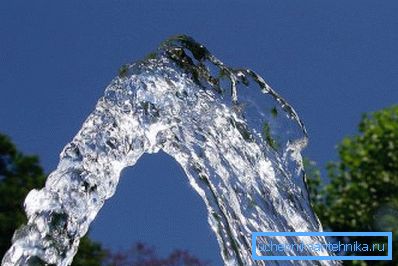
Types of wells
Water wells differ in depth. They can be drilled to aquifers, occurring in different layers of the earth's crust at a particular distance from its surface. Depending on the depth, they are divided into two types - sand and artesian.
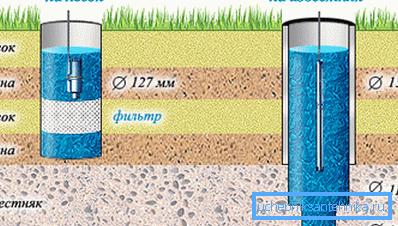
Sand (filter) wells
They are being drilled to the nearest aquifer lying in sandy soils. It is located at a depth of 10 to 50 meters from ground level.
The supplied water contains a lot of mechanical impurities, so the lower part of the pipe immersed in the well is necessarily supplied with a mesh filter that delays coarse fractions. Additional fine filters are installed on the water pipe.
Note! The instruction requires the mandatory examination of water from sand wells to determine the composition and content of impurities harmful to health.
Drilling "on the sand" is carried out quickly, is inexpensive, but this method has several disadvantages:
- The service life of such wells, as a rule, is limited to several years, as they become silted over time;
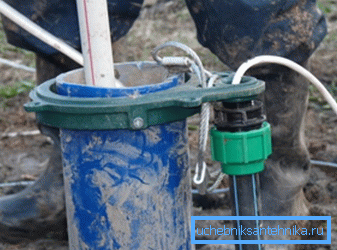
- The volume of water supplied is small, it may not be enough for an uninterrupted supply of a large farm;
- Water from sand wells often contains harmful organic impurities and requires additional cleaning and disinfection.
To extend the life of the filter well, you need to use it constantly.
Artesian (deep) wells
Drilled to the lime layers occurring at great depths. In different regions, it can vary from 20-30 to 200-250 meters. The aquifers in the limestone are very thick, and the artesian wells practically do not silt and last 50-100 years.
The process of drilling is quite complicated and time consuming, it requires the use of special equipment, and therefore the price of such work is high. But the costs are paid off by the quality of water, its unlimited consumption and long life of the source.
Attention! Water from an artesian well also needs to be examined, since it may contain hydrogen sulfide and salts of heavy metals.
Drilling methods
Water wells are most often arranged with the help of mechanized drilling rigs. Their use is associated with high costs and inconvenience due to the presence of heavy equipment on the site. But in the presence of complex soils or the desire to “get to the bottom” of the artesian water, there is no other way out.
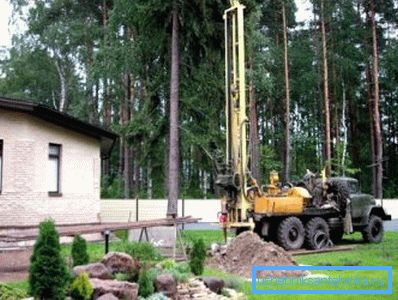
If you need a relatively shallow sand well for technical needs (for example, for irrigation), it can be drilled manually. To do this, you need a drill (or several types of it for different types of soil), a tripod with a winch and assistants.
Council If you are a pioneer in drilling in your area, and you do not have many neighbors with already existing wells of a certain depth, get information about the occurrence of aquifers in your area in the district administration so as not to act blindly.
Auger drilling
Many summer residents, having learned how much it costs to drill a well under water, decide to do this business on their own. If the depth of the water layer does not exceed 20 m, this is quite realistic.
First you need to decide on the diameter of the drill, which should be several centimeters larger than the diameter of the casing.
The drilling process looks like this:
- A hole about 1 m deep and 1.5x1.5 m in size is dug in the chosen place, the walls of which are reinforced with wooden boards;
- The auger drill is mounted on a tripod and is turned clockwise in the upper part with handles until it is fully submerged;
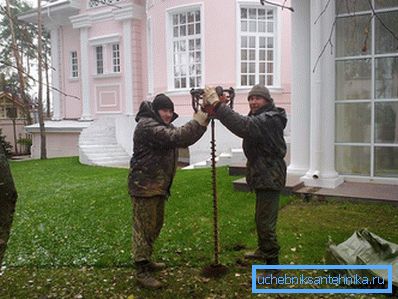
- Using a winch, the drill is pulled out to the surface and cleaned of the ground;
- The drill is re-immersed in the well and continues the process until it reaches the aquifer. If necessary, it is extended with special metal rods;
Council When buying or renting a drill, specify for which soils it is intended. There are spoon, spiral drills, coils, chisels, zhelonki, each of which is used in certain layers.
- A well with the help of a choke is cleaned from crumbling the soil to solid bottom, which is covered with gravel;
- The last stage is the installation of a casing with a fine-mesh filter in the finished well.
The space between the pipe and the walls of the well must be filled with sand or filled with a solution.
Drilling with lowering pipe
The well can be drilled with your own hands and in another way, as soon as the layers pass, the casing is immersed in it. The diameter of the drill should be such that it can be easily lowered and pulled out of the pipe.
The difference of this technology is that the drill immediately works inside the casing. When it is removed for cleaning, the pipe is driven into the ground to the drilled depth with a sledge hammer.
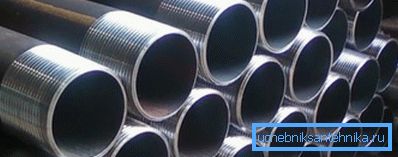
Council Carefully monitor the occurrence of the aquifer. The pipe should not be lowered into it very deeply so as not to block the access of water.
In this case, a purchase filter is lowered into the well, the diameter of which should correspond to the inner diameter of the casing string.
You can start using the well after several pumpings of water, when it becomes clean and transparent.
Conclusion
Such a brief description is not able to give a complete picture of the drilling process and the construction of a water well. For more information, see the video in this article.